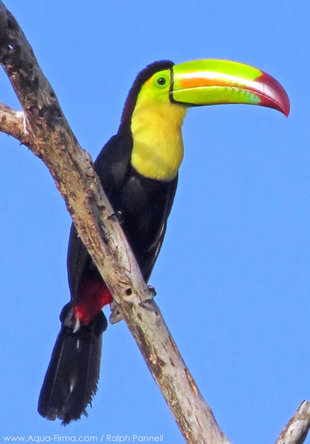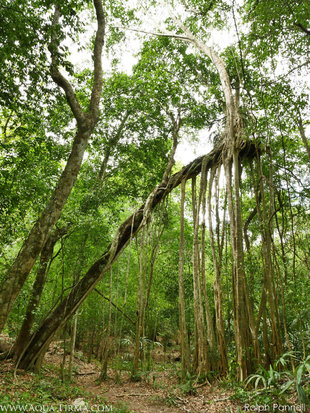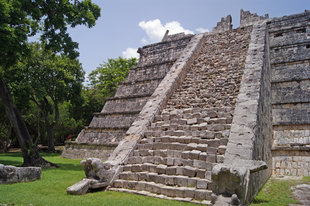This journey takes you deep inside the Mexican states of Yucatan and Campeche, to explore the best of what these areas have to offer. We include a few must-see locations such as Chichen Itza; but delve well beyond, for wildlife, scenery, cenotes and lesser known Mayan and pre-Mayan sites.
Our most distant point is huge Mayan complex of Calakmul, which lies deep within the forests of the Calakmul Biosphere Reserve, on the border between Mexico and Guatemala. Our final approach to the temple site takes us 50km through wildlife rich forest. Don't be surprised if a Toucan, Tayra or family of Coatimundis pass across the road in front of you.
Calakmul is that bit too far from popular tourist centres for most visitors make it to. For such a jaw-dropping site it will surprise you how few other visitors you encounter. We can walk up many of the temples here and on some you will be the only ones, with views over seemingly endless forest in all directions. Mayan temples emerge above the canopy all around, whilst a constant hum of insects and birds is broken at times by the reverberating roar of Howler Monkeys. The tops of these pyramids are like canopy towers, providing distant views and vantage points to peer into tropical treetops where avian activity is greatest.
You will enjoy similarly spectacular views over other forest areas on this journey. One of these is a Mayan Community Jaguar Reserve, where you will stay one night at a tented camp, established for some of the country's leading wildlife researchers. We will walk along research transects and stake out lakeside areas in search of birdlife and wildlife. Jaguars are without a doubt present here, as you will see from tracks your guide will find for you; but most likely that these big cats will evade sight of us.
At forest lake in the Otoch Ma'ax Yetel Kooh Reserve, we will head out in an open canoe as dawn mist rises from the water. The forest interior here has the remains of ancient Mayan activity, but is now taken over by large troops of Spider monkeys: Ateles geoffroyi yucatanensis to be precise - a subspecies found only in the Yucatan. Like Howler Monkeys, Spider Monkeys have prehensile tails which, like a fifth limb, are able to grip branches.
Caves are widespread throughout the Yucatan, since much of the land is limestone - formerly coral reef, forced above sea level when the Chicxulub Meteor struck the Earth 66 million years ago. This was the event which wiped out the dinosaurs. Where the limestone is undermined by underground water and weighed down by trees, great sections collapse to make cenotes. These holes expose a world of underground rivers and caves below. We will swim and snorkel in some of the most beautiful of these, enjoying crystal clear waters and views into the world's largest system of caves.
We will often see bats roosting in the cenotes; but there are two cave systems we visit which provide us with a couple of the world's most exciting bat spectacles. The first location requires us to walk into a cave, just as thousands of bats are leaving into the early night sky. We will don helmets, head torches and overalls to edge ourselves into narrow tunnels where snakes have adapted to catch bats as they fly in and out of the cave. Snakes literally hang from the cave ceiling, lunging at bats as they fly past.
The other bat highlight we will take you to is place where we can stand with touching distance of a twister of thousands of these mammals. We will walk to a point about 30m above a cave exit, where at sunset, everything looks quiet - no bats in sight. As the light dims, a few bats start to emerge, flying in a tight circle in front of us. More bats join them - a few at first, but then hundreds and eventually thousands, maintaining the tight circle, filling the space vertically from the cave entrance 30m below us, to the top of a forest covered rockface about 50m above. The sound of wings flapping and echo soundings becomes intense, but then begins to fade as bats to spread out into the night sky, separating to go and feed.
Birdlife is another special feature of this journey. At a place called Rio Lagartos (Alligator River) in the Gulf of Mexico, we find the densest concentrations of Flamingos in the country. We also find some beautifully coloured lagoons and mangrove-lined estuaries with white ibis, snowy egrets, red egrets, tiger herons and crocodiles.
At the Coba ruins and just outside Xian Ka'an Man & Biosphere Reserve, we go in search of classical tropical birds such as hummingbirds, toucans, aracaris and giant tropical woodpeckers. We can also find great birdlife around our base close to Calakmul, where we use a water tower and nearby Mayan temples to take vantage above the canopy, to see parrots, parakeets and colourful tanagers.
Itinerary
Mayan Explorer into the Land of the Jaguar
Day 1 - Cancun to Chichen Itza & Valladolid
Early morning, your driver and guide will greet you at your hotel in Cancun, or at Cancun airport; and take you west to Chichen Itza. We will guide you around this spectacular Mayan and pre-Mayan complex, providing a great opportunity to lay the foundations of understanding Mayan history and culture.
Chichen Itza is probably the hottest location you will visit, so from here we will take you to cool down with a swim and snorkel at the local Chooj ha Cenote.
Cooled and dried, we will drive to you to one of the prettiest Spanish colonial towns in the region: Valladolid. Here we will provide a late lunch and in the afternoon, if you wish, take you to visit local museums, or a traditional bar.
You will be staying in a hotel called Meson del Marques, which is situated on the opposite side of the plaza to the cathedral.
Day 2 - Rio Lagartos & Los Colorados
You can enjoy a leisurely breakfast followed by a walk inside the cathedral.
We will then drive north to the Gulf of Mexico, to visit the mangroves and lagoons of Rio Lagartos and Las Colorados. Flamingos will be our primary target, but there is much other birdlife here besides, as well as crocodiles.
Day 3 - Coba Mayan Site & Spider Monkey Forest
Early morning, your guide will take you in search of birds and nature at Rio Lagartos and Las Colorados.
We will then drive you to the Mayan site of Coba. Whilst at Chichen Itza, climbing the central pyramid is not permitted, we can walk up Coba's pyramid for commanding views over the surrounding forest.
From Coba, we will take you to a reserve called Otoch Ma'ax Yetel Kooh. We can often find particularly large troops on endemic Yucatan Spider Monkeys in the forest here.
Overnight at Coba.
Day 4 - Lake & Bat Caves
Very early morning, we will head back to Otoch Ma'ax Yetel Kooh, and enter a lake in open canoes. Mist rises from the water a daylight begins to emerge - it is an incredibly tranquil experience paddling slowly around the forest-fringed edges of the lake.
A pack breakfast will be provided, which you can eat on a jetty or at the top of a forest canopy tower.
From the lake, we will head south to another forest reserve. Here we find the caves where snakes prey on bats on the wing. You will arrive in daylight and be provided with overalls, helmet, head torch and a bicycle. You will then cycle a couple of miles over flat terrain to the opening to the bat cave.
As the light fades, you will be able to watch hundreds of bats emerging from the cave, before you descend in a large chamber; and then stoop low onto your knees into narrow chambers where snakes hang from the ceiling. Keeping as quiet as possible, you can watch snakes try to capture bats in flight.
You can cycle or walk back to the vehicle. It will be late, but there's not much by way of accommodation here; so we will drive south to the lovely lakeside town of Bacalar for overnight.
Day 5 - Bacalar - Kohunlich - Mayan Jaguar Reserve
Breakfast will be at a leisurely time, since you will be a little tired from the night before.
After viewing the lake, we will drive you for a late morning visit to the Mayan temples at Kohunlich.
We will then continue to the Mayan community Jaguar Reserve, walking through some lovely forest here to the top of a pyramid engulfed in vegetation. You can enjoy views over the vast area of the reserve and beyond.
You will then be taken to a Jaguar Research Camp, walking nearby trails in search of jaguar and tapir tracks; and wildlife such as spider monkeys.
As dusk approaches, you can take up position at the side of a lake to watch the birdlife and Morelet's crocodiles. These reach a modest 3 meters and are found only in Mexico, Belize and Guatemala.
Overnight clean adventure camping in a semi-permanent tented camp.
Day 6 - Jaguar Tracks - Chiccana
Daybreak can be spent watching over the lake.
After an early breakfast, your guide will take you walking on trails in search of wildlife and their tracks.
As the day progresses and wildlife activity reduces, we will take you to an absolutely fascinating pre-Colombian pyramid site, where these is also a canopy shaded pok-ta-ok, or Mayan football pitch.
From here we will drive west into Campeche and a hotel opposite the Chicanna Mayan site. There will be time for a bit of birdwatching from a high water tower.
Day 7 - Calakmul Biosphere Reserve & the Bat Typhoon
If you wish, we can take you for some birdwatching before breakfast.
We will have breakfast early, in order to reach the gates of Calakmul as they open. We will stay within the reserve until the gates close. This will give us enough time to get to visit another location where we can see the 'bat typhoon'.
Overnight at Chicanna.
Day 8 - Chicanna - Bacalar - Tulum
If you wish, we can take you for some birdwatching before breakfast.
After breakfast, visit the Chicanna Mayan site.
We will then drive you east, out of Campeche and back into Yucatan, stopping at Bacalar for a lunch at a lovely art café. We will then continue north to a small hotel in Tulum.
Day 9 - Tulum - Xian Ka'an Biosphere Reserve - Cancun
Early morning, we will head to the edge of the Xian Ka'an Man & Biosphere Reserve, walking through a village where birdwatching is very good.
You can then agree on one of three options. One is to visit the coastal Mayan complex of Tulum. Another is to swim in a cenote. The third is to snorkel in the Caribbean sea, at some seagrass beds where juvenile Green Turtles are easy to see.
6pm drop off at Cancun airport; or a hotel in Cancun if you are staying longer, or require an overnight before your flight home.
Dates
Price includes
Land transportation in air conditioned van
All accommodation
Breakfasts
Entrance fees according to all locations within itinerary
Bilingual guide
Equipment needed for trip
Not included
Airfare
Lunches and dinners
Beverages
Personal expenses
Tips















